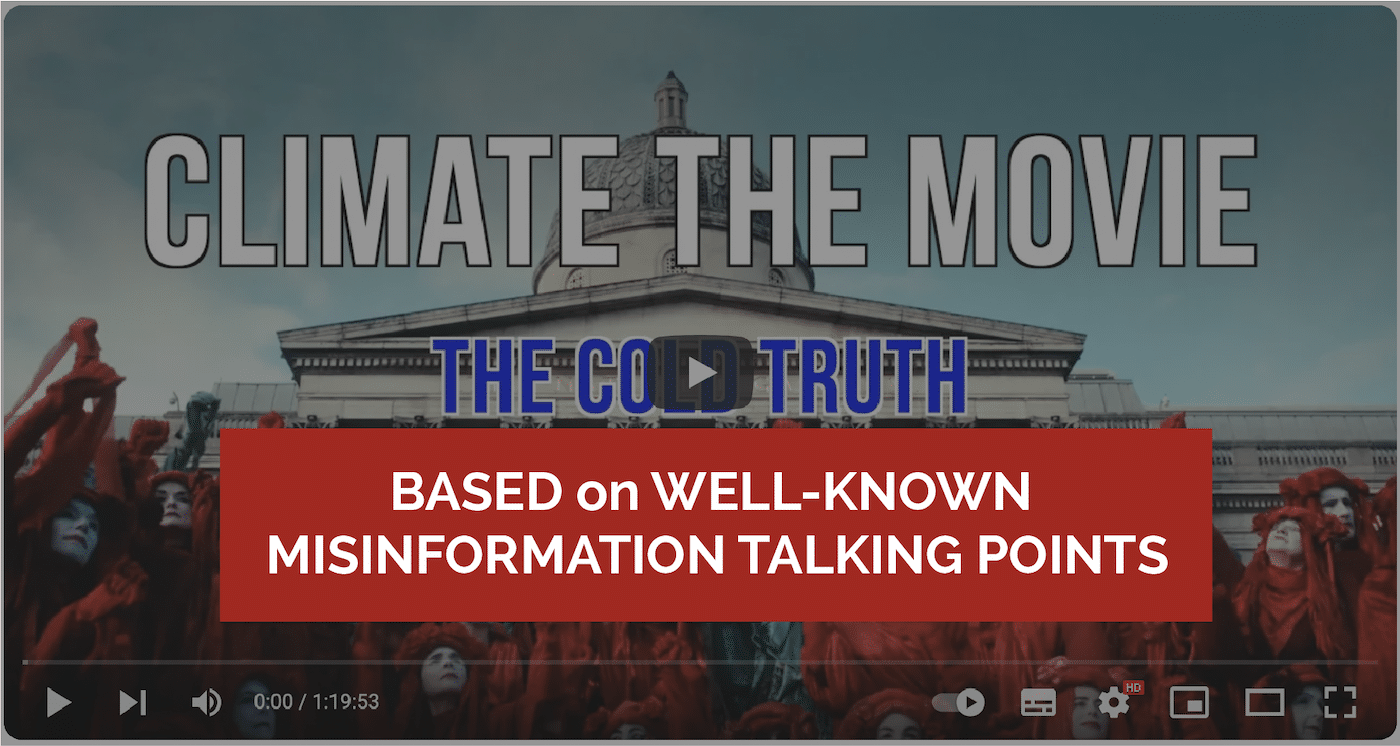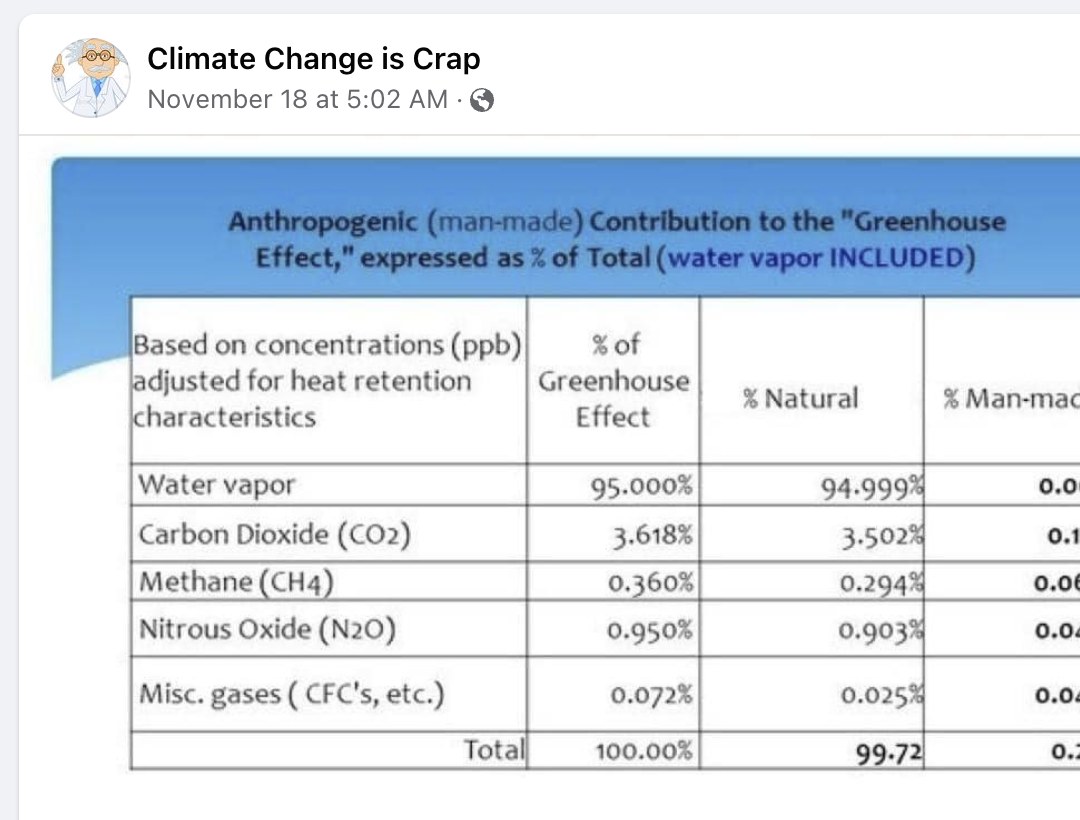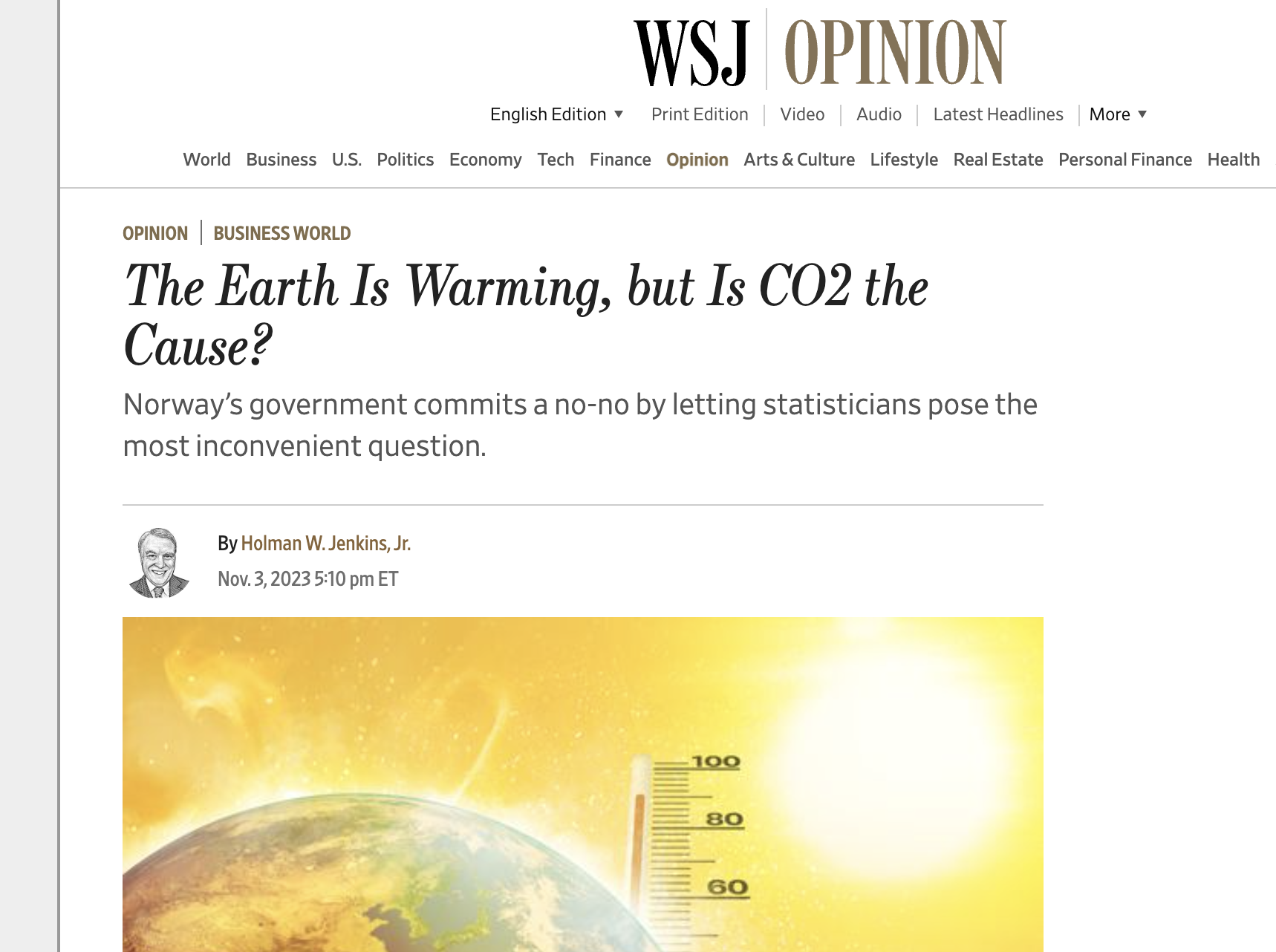- Climate
- Energy
Commentary in The Australian by Ian Plimer relies on false claims to make its case
Reviewed content
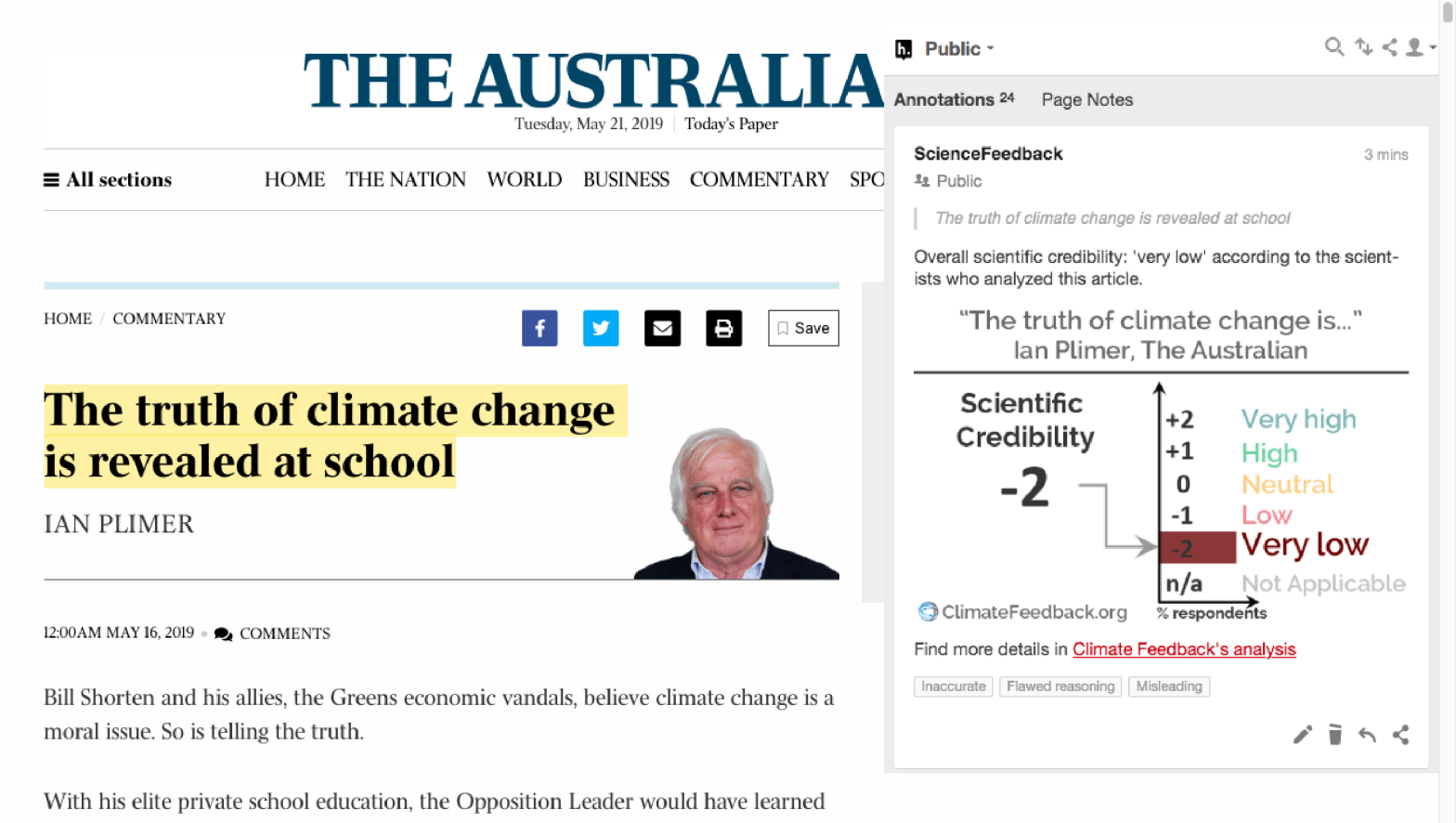
Headline: "The truth of climate change is revealed at school"
Published in The Australian, by Ian Plimer, on 2019-05-16.

Scientists’ Feedback
SUMMARY
This commentary by Ian Plimer, published by The Australian, criticizes a political leader’s stance on climate change, but makes a number of verifiably false claims about climate science and energy systems as the foundation of that argument.
Scientists who reviewed the article found that it repeated common false claims about climate science, stating that human greenhouse gas emissions are trivial and not responsible for current climate change, for example. These claims are contradicted by the available evidence and decades of published scientific research.
You can read the article here. You can also install the Hypothesis browser extension to read the scientists’ annotations in context.
REVIEWERS’ OVERALL FEEDBACK
These comments are the overall assessment of scientists on the article, they are substantiated by their knowledge in the field and by the content of the analysis in the annotations on the article.

Professor, University of New South Wales
This article is misleading, derogatory, and teeming with false statements. The arguments in this article have been put forward by climate deniers before, and they all have been proven wrong by scientists. There is nothing new; déjà vu effect.

Scientist, University of Bonn, Germany
This op-ed by Ian Plimer in The Australian is exceptional. I see no way to honestly summarize how bad it is without sounding unprofessional.

Research Associate, Colorado State University/NASA JPL
This article mixes falsehoods and logical errors. For example, the evidence is overwhelming that most recent warming is human caused, and that solar panels and wind turbines generate multiple times more power than was used in their construction: this article says the opposite to both of these facts.
Notes:
[1] See the rating guidelines used for article evaluations.
[2] Each evaluation is independent. Scientists’ comments are all published at the same time.
Annotations
The statements quoted below are from the article; comments are from the reviewers (and are lightly edited for clarity).
[…] the Roman Warming, the Dark Ages, the Medieval Warming and the Little Ice Age. These took place before industrialisation and were all driven by changes in the sun.

Professor, University of New South Wales
These climate fluctuations were small, regional and at a much smaller scale than what the planet experiences today. None of them were globally as warm as today. They were also driven by other forcings than greenhouse gases. The author is confused between small-scale natural variability and long-term irreversible large-scale change.
Climate Feedback:
To learn more about the little ice age, read our review of one of the many articles wrongly predicting an imminent cooling. Professor Michael Lockwood explains: “The term “mini ice age” is inherently misleading in the context of solar variations as it implies a global decrease in temperatures and at all times of year. This does not apply at all to the solar Maunder minimum. Temperature observations from central England show that summers during the Maunder minimum were, if anything, slightly warmer than average[…] there was increased occurrence of cold winters during the Maunder minimum but this is an effect of jet stream behaviour specific to northern Europe and the USA and not a global ice age.”
natural warm times, like now, bring great prosperity, increased longevity and less disease, whereas Jack Frost brings death, depopulation and economic stresses.

Professor, University of New South Wales
This is a common misconception. We are not talking about minor climate fluctuations, we are experiencing a major, abrupt climate change. Because current climate change is so fast, ecosystems are at risk, infrastructure is at risk, and the result will certainly not bring great prosperity. Climate change related health impacts are also on the rise, so there will certainly not be “less disease”
Like countless other organisms, we move and adapt when the environment changes. Species thrive when it is warm.

Professor, University of New South Wales
The rate of change is important. CO2 concentrations and temperatures are changing at an unprecedented rate, which will make it impossible for many organisms to “move and adapt”.
carbon dioxide is the food of life and without this natural gas, which occurs in space and all planets, there would be no life.

Scientist, University of Bonn, Germany
The same goes for water, it is natural and necessary for life, you can still drown in a flood.
Too much and too little carbon dioxide and water is bad for you. The proposal is to stop messing with our climate system by changing the CO2 from the level it had when human civilization was built.
when 3 per cent of total annual global emissions of carbon dioxide are from humans and Australia produces 1.3 per cent of this 3 per cent, then no amount of emissions reduction here will have any effect on global climate.

Postdoctoral Research fellow, Harvard University
This is enormously misleading; humans are entirely responsible for the rapid increase in the greenhouse gas concentrations within the atmosphere over the last 150 years, primarily through the burning of fossil fuels.

Professor, University of New South Wales
The natural emissions are balanced by natural sinks (comparable to our bank accounts, salary comes in, rent or mortgage goes out, grocery bills go out, the incoming and outgoing fluxes are high, but at the end of the month we end up with more or less the same amount of money we started with). Human emissions are on top of this fine natural balance. Humans add CO2 but they don’t remove CO2. And while this would be great news for our bank accounts, it’s not great news for our planet.

Scientist, University of Bonn, Germany
Human CO2 emissions are two times larger than the increase of the CO2 concentration in the atmosphere. The oceans and vegetation fortunately have taken up the other half1-2.
Humans are fully responsible for the atmospheric CO2 increase.
We can only fight climate change if everyone does their part. Australia doing more makes other countries willing to do more.
- 1 – Le Quéré et al (2018) Global Carbon Budget 2018. Earth Systems Science Data.
- 2- IPCC (2013) Section 6.3.1 Carbon Dioxide Emissions and Their Fate Since 1750
Climate Feedback:
One reason we know that the increase in atmospheric CO2 concentrations is the result of human activities is because the carbon from fossil fuels has a different isotopic composition. Learn more in this article.
whenever in the past there was an explosion of plant life, the carbon dioxide content was far higher than at present.

Research Associate, Colorado State University/NASA JPL
The last time carbon dioxide levels were as high as we’re on course for, sea levels were 25-40 metres higher1.
The homes of billions of people would be under this sea level. This is projected to take a long time, but even with relatively low emissions we expect tens to hundreds of millions of people’s homes to be flood risks due to rising seas this century. And annual flooding costs of trillions of dollars without heavy investment in flood defences or abandoning cities2.
If you think that potentially causing hundreds of millions of refugees and trillions of dollars in damages is fine because some plants did well in the same conditions millions of years ago when humans weren’t around, then you could support this article.
- 1- Tripati et al (2009) Coupling of CO2 and Ice Sheet Stability Over Major Climate Transitions of the Last 20 Million Years, Science
- 2- Jevrejeva et al (2018) Flood damage costs under the sea level rise with warming of 1.5 °C and 2 °C, Environmental Research Letters
If we halve the carbon dioxide content of the atmosphere, all life dies.

Professor, University of New South Wales
If we halve the present day carbon dioxide content in the atmosphere, we will end up with the most common CO2 concentrations over the past 2 million years… those during an ice age. Life did not die. All the species we know today (including hominins) actually lived through several cycles of ice ages.
for thousands of millions of years the Earth has been changing, with cycles and one-off events such as an asteroid impact, super-volcano or a supernova explosion.

Professor, University of New South Wales
That is true. And there were several mass extinctions associated with these events. As far as we can go back in time based on our geological climate proxies, past natural climate change has very likely been much slower (at least by a factor 10) than what we experience today.
It has yet to be demonstrated that the climate change today is any different from those of the past.

Professor, University of New South Wales
This has been demonstrated. See, for example, recent IPCC reports.

Scientist, University of Bonn, Germany
Trivially wrong. This time climate change is due to human CO2 emissions. That has not happened before.
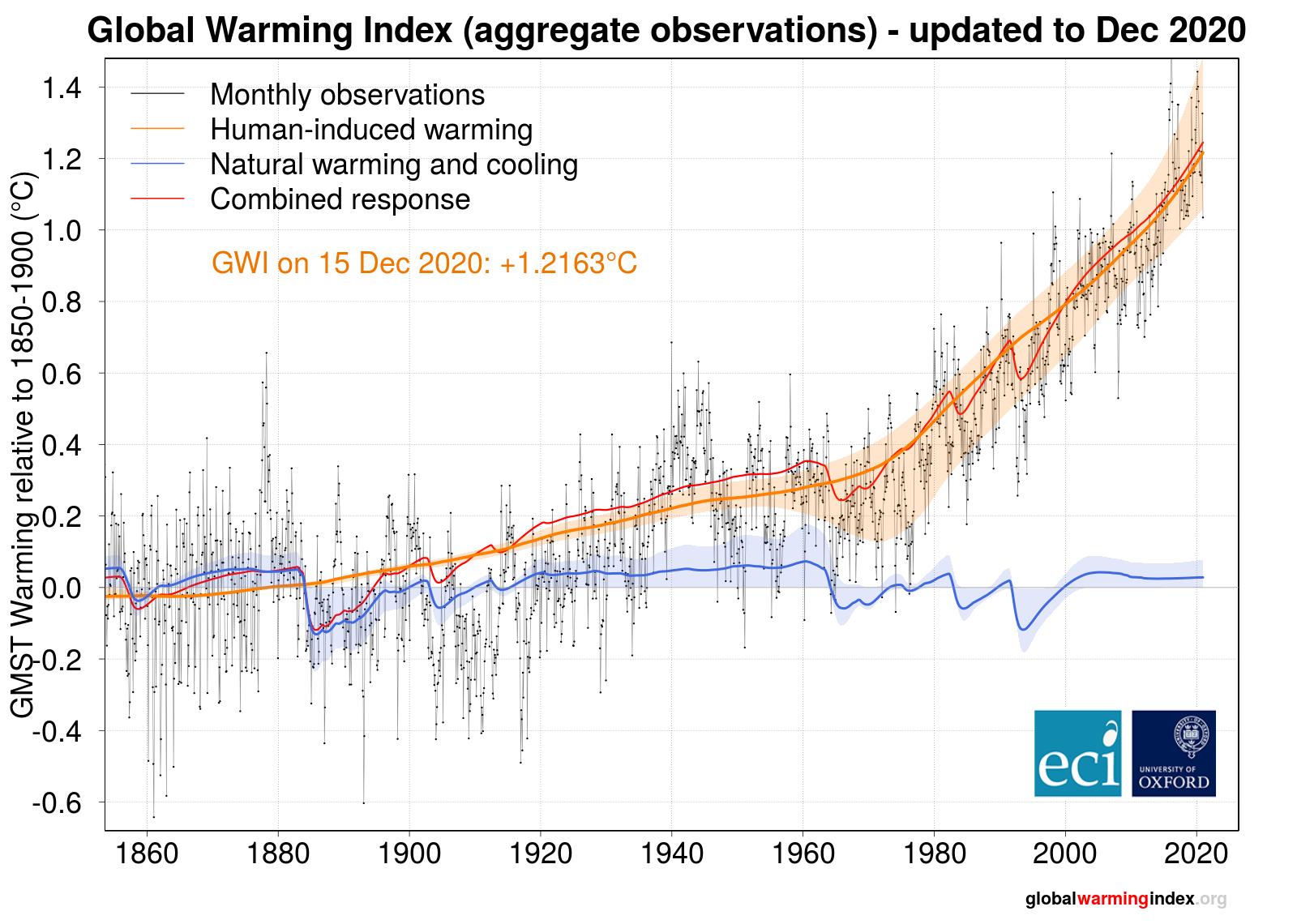
it still has not been shown that human emissions of carbon dioxide drive global warming.

Professor, University of New South Wales
This statement is wrong. CO2 is a greenhouse gas and human emissions are increasing its concentration. Human emissions therefore drive global warming1. This can be measured, it can be explained theoretically and it can be seen in the past evolution of temperatures and CO2.
- 1- Stips et al (2016) On the causal structure between CO2 and global temperature, Scientific Reports

Postdoctoral Research fellow, Harvard University
There is a mountain of evidence for the importance of carbon dioxide for Earth’s climate. We have known for over 100 years that CO2 is a greenhouse gas; without CO2 in the atmosphere, Earth’s surface would be tens of degrees colder, and probably not habitable for life. Increasing the CO2 concentration enhances the greenhouse effect, warming the Earth’s surface; this enhancement of the greenhouse effect has been observed by satellites. Furthermore, differences in the concentration of CO2 are known to be important for climate change that has occurred in Earth’s distant past, from hundreds of thousands to millions of years ago.

Scientist, University of Bonn, Germany
This is so trivially wrong and such old well-established science, that I hope a Wikipedia link is allowed.
Climate Feedback:
For a beginner’s guide, read this article by NASA.
[subsidies for wind and solar] add to emissions because coal-fired electricity needs to be on standby for when there is no wind or sunshine.

Research Associate, Colorado State University/NASA JPL
Baseless and, in regions where this has been studied, false.
For example, in Illinois1. And this ignores more efficient ways of reducing backup emissions, such as energy storage like batteries.
The amount of energy used to construct solar and wind facilities is greater than they produce in their working lives.

Research Associate, Colorado State University/NASA JPL
This is false.
The average working wind farm that has been studied produces about 20 times more energy than was used to make them1. Some wind farms are better, some are worse. Solar, too, produces more energy than was used to make the solar farm.
- 1- Kubiszewski et al (2010) Meta-analysis of net energy return for wind power systems, Renewable Energy

Senior Scientist, Carnegie Institution for Science
Numbers for “Energy Return on Investment” (EROI) are all over the place, but a nice summary with references to supporting information was produced for Scientific American by Mason Inman for the April 2013 edition of Scientific American. Mason estimated that wind returns about 20 times the energy input and solar around 6 times their energy input. While these numbers do depend on a range of assumptions, the idea that these ratios are less than one is wrong and not defensible.
The construction of wind turbines and solar panels does result in some carbon dioxide emission but far less than would be emitted were that electricity generated using fossil fuels such as coal, gas, or oil. Therefore, if the alternative is fossil fuels, these technologies help avoid carbon dioxide emissions.
It should be noted that Energy Return on Investment is likely to increase over time as the economy becomes more efficient and thus economic inputs to the production of energy technologies becomes less energy intensive.
Mark Diesendorf, Honorary Associate Professor, University of New South Wales:
The energy input to a wind farm is generated in 3 to 6 months of its operation, depending on location, and the energy input to a solar farm is generated in 1 to 3 years of its operation, depending on location and type of solar panel used. Both wind and solar farms have expected lifetimes of about 25 years.
- Lunardi et al (2018) Life cycle assessment on PERC solar modules, Solar Energy Materials and Solar Cells
- Martínez et al (2009) Life cycle assessment of a multi-megawatt wind turbine, Renewable Energy
- Raugei (2012) The energy return on energy investment (EROI) of photovoltaics: Methodology and comparisons with fossil fuel life cycles, Energy Policy
“As soon as renewables were introduced into the grid, electricity prices increased and delivery became unreliable. Increased electricity costs have created unemployment, and many pensioners and the poor cannot afford electricity. An increase in renewables will make matters worse.”

Senior Scientist, Carnegie Institution for Science
Today, variable renewable energy sources do present challenges to electricity grid management and do result in price volatility. If reliable electricity is the goal, given the high cost of electricity storage and the lack of continental scale electricity grids, deep penetration of intermittent renewables does increase system costs, narrowly defined.
However, it is important to bear in mind that fossil fuels impose a huge cost on the environment that is not monetized and reflected in electricity prices to the consumer. If the full cost, including environmental costs, of fossil fuel energy were passed on to the consumer, on most analyses expanded renewable energy would be a net cost saver. Fossil fuels have been getting a free ride by imposing costs to current and future generations around the world.
Different jurisdictions adjust electricity costs in different ways. The Australian market, like the market in Texas, is notable for market structures with high price volatility. Other markets put more emphasis on maintaining capacity to deal with spikes in demand or crevasses in renewable energy generation. This tends to spread costs out over time and allow businesses to better plan the electricity costs, but there is an added cost to building the extra generation capacity. There is no free lunch. Low cost of fossil fuel electricity generation comes at the cost of imposing climate change throughout the world and for many generations to come. Avoiding imposing these costs on others means imposing a little more cost on people using electricity. The goal of clean energy research and development is to make this “little more cost” as little as possible, and perhaps even eliminate the cost differential entirely.
Renewables such as wind turbines are environmentally disastrous because they pollute a huge land area, slice and dice birds and bats, kill insects that are bird food, create health problems for humans who live within kilometres of them, leave toxins around the turbine site and despoil the landscape.

Research Associate, Colorado State University/NASA JPL
There is no comparison here with the alternatives. For example, the claimed wind turbine health damages, for which the author shows evidence of zero deaths, should be compared with the millions of deaths that the World Health Organisation links to pollution every year, much of which is from fossil fuels.

